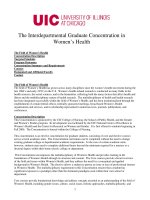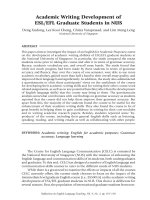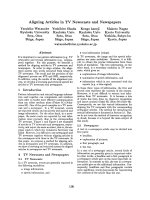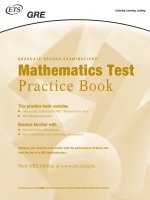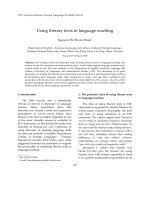Graduate texts in mathematics readings in mathematics v 123
Bạn đang xem bản rút gọn của tài liệu. Xem và tải ngay bản đầy đủ của tài liệu tại đây (9.77 MB, 418 trang )
H.-D. Ebbinghaus H. Hermes
F. Hirzebruch M. Koecher
K. Mainzer J. Neukirch
A. Prestel A. Remmert
Numbers
4
Springer
www.pdfgrip.com
Graduate Texts in Mathematics
1 23
Readings in Mathematics
Editorial Board
S. Axier
Springer
New York
Berlin
Heidelberg
Barcelona
Budapest
Hong Kong
London
Milan
Paris
Santa Clara
Singapore
Tokyo
F.
W. Gehring
P. R. f{almos
www.pdfgrip.com
Graduate Texts in Mathematics
Readings in Mathematics
Ebbinghaus Hermes/Hi ebruch/Koecher/Mainzer/NeukircWPrestellRemmert: Numbers
Fulton/Harns: Representation Theory: A First Course
Remmert: Theory of complex Functions
Undergraduate Texts in Mathematics
Readings in Mathematics
Anglin: Mathematics: A Concise History and Philosophy
Anglin/Lainbek: The Heritage of Thales
Bres.soud: Second Year calculu.s
Hairer/Wanner: Analysis by Its History
HammerlinlHoffmann: Numerical Mathematics
Isaac: The Pleasures of Probability
Samuel: Projeclive Geometrt
www.pdfgrip.com
H.-D. Ebbinghaus H. Hermes
F. Hirzebruch M. Koecher K. Mainzer
J. Neukirch A. Prestel R. Remmert
Numbers
With an Introduction by K. Lamotke
Translated by H.L.S. Orde
Edited by J.H. Ewing
With 24 Illustrations
Springer
www.pdfgrip.com
Heini-Dieter Ebbinghaus
Hans Hermes
Mathematisches Institut
Freiburg
Alberistralle 23b, D-79 104
Freiburg. Germany
Friedrich 1{irzebruch
Man-Planck-Institut liii
Mathematik
Gotifried-Claren-StraBe 26
D-53225 Bonn. Germany
Klaus Lamotke (Editor of
German Edition)
Mathematisches Institut
der Universitat 7.0 Köln
Weyertal 86—90. D5093 I
Max Koecher (1924—1990)
Reinhold Remmert
Mathematisches Institut
Universitat Munster
Einsteinstral3e 62
D-48 149 MOnster, Germany
Klaus Mainzer
Lehrstuhl für Philosophie und
Wissenschaflstheorie
LJniversität Augsburg
Universitätsstral3e 10
D-86 195 Augshurg, Germany
H.L.S. Orde (Translator)
Bressenden
Jurgen Neukirch
Fachbereich Mathematik
UniversitätsstraEie 31
l)-93053 Regensburg. Germany
Alexander Prestel
Fakuluit fỹr Mathematik
Universitọt Konstanz
Postfach 5560, D-78434
Konstanz, Germany
John H. Ewing (Editor of
Enỗ'lish Edition)
Department of Mathematics
Indiana University
Bloomington. IN 47405, USA
Biddenden near Ashlord
Kent TN27 %DU. UK
Koln. Germany
Editorial Board
S. Axler
Department of Mathematics
Michigan State University
East I.ansing. Ml 48824. USA
F.W. Gehring
Department of Mathematics
University of Michigan
Ann Arbor, Ml 48109. USA
P.R. Halmos
Department of Mathematics
Santa Clara University
Santa Clara, CA 95053, USA
Mathematics Subject Classification (1991): II -XX, 11-03
Library of Congress Cataioging-in Publication Data
Zahlen. Grundwissen Mathcmatik I. English
Numbers / Heinz-Dicier Ebbinghaus
let all. with an
introduction by Klaus Lamotkc: translated by H.L S Orde: editcd
by John H Ewing.
p. ctn —(Readings in mathematics)
Include.', bibliographical rcfcrcnccs.
ISBN 0-387-97497-0
Number theory. I. Ebbinghaus. Heinz-Dieter II. Ewing.
I
.
.
John H. Ill Series: Graduate texts in mathematics. Readings
in mathematics.
QA241.Z3413 1991
5)2' 7—dc2()
89-48588
Pnnted on acid-free paper
This book is a translation of the second edition of Zahlen. Grundwissen Malhematik 1. Spnngcr-Verlag.
1988 The pecsent volume is the lursi softcover edition of the prcviously published hardcover version
(ISBN 0-387-97202-I).
© 1991 Springer-Verlag New York Inc.
All nghts reserved This work may not be translated or copied in whole or in part without the written permission
of the publisher (springer-Verlag New York. Inc . 175 Fifth Avenue. New York. NY 10010. USA). except for
brief
in connection with reviews or scholarly analysis. Use in connection with any form of information
storage and retneval, electronic adaNation. computer software, or by similar or dissimilar methodology now known
or hereafter developed is forbidden.
The use of general descriptive names, trade names, trademarks. etc.. in this publication, even ii the former are
not especially identified, is not to be taken as a sign that such names, as understood by the Trade Marks and
Merchandise Marks Act. may accordingly be used freely by anyone.
Camera-ready copy prepared using LaT1.X
Printed and bound by R.R. Donnelley & Sons. Han'isonburg. Virginia
Printed in the United States of America
9 87 6 5 4 3 (Corrected third printing. 1995
ISBN 0-387-97497-0 Spnnger-Verlag New York Berlin Heidelberg
ISBN 3-540-97497-0 Springer-Verlag Berlin Heidelberg New York
www.pdfgrip.com
Preface to the English Edition
A book about numbers sounds rather dull. This one is not. Instead it is a
lively story about one thread of mathematics—the concept of "number"—
told by eight authors and organized into a historical narrative that leads
the reader from ancient Egypt to the late twentieth century. It is a story
that begins with some of the simplest ideas of mathematics and ends with
some of the most complex. It is a story that mathematicians, both amateur
and professional, ought to know.
Why write about numbers? Mathematicians have always found it difficult to develop broad perspective about their subject. While we each view
our specialty as having roots in the past, and sometimes having connections to other specialties in the present, we seldom see the panorama of
mathematical development over thousands of years. Numbers attempts to
give that broad perspective, from hieroglyphs to K-theory, from Dedekind
cuts to nonstandard analysis. Who first used the standard notation for
ir (and who made it standard)? Who were the "quaternionists" (and can
their zeal for quaternions tell us anything about the recent controversy
concerning Chaos)? What happened to the endless supply of "hypercomplex numbers" or to quaternionic function theory? How can the study of
maps from projective space to itself give information about algebras? How
did mathematicians resurrect the "ghosts of departed quantities" by reintroducing infinitesimals after 200 years? How can games be numbers and
numbers be games? This is mathematical culture, but it's not the sort of
culture one finds in scholarly tomes; it's lively culture, meant to entertain
as well as to inform.
This is not a book for the faint-hearted, however. While it starts with
material that every undergraduate could (and should) learn, the reader is
progressively challenged as the chapters progress into the twentieth century.
The chapters often tell about people and events, but they primarily tell
about mathematics. Undergraduates can certainly read large parts of this
book, but mastering the material in late chapters requires work, even for
mature mathematicians. This is a book that can be read on several levels,
by amateurs and professionals alike.
The German edition of this book, Zahien, has been quite successful.
There was a temptation to abbreviate the English language translation
by making it less complete and more compact. We have instead tried to
produce a faithful translation of the entire original, which can serve as a
scholarly reference as well as casual reading. For this reason, quotations
www.pdfgrip.com
vi
Preface to the English Edition
are included along with translations and references to source material in
foreign languages are included along with additional references (usually
more recent) in English.
Translations seldom come into the world without some labor pains. Authors and translators never agree completely, especially when there are
eight authors and one translator, all of whom speak both languages. My
job was to act as referee in questions of language and style, and I did so in
a way that likely made neither side happy. I apologize to all.
Finally, I would like to thank my colleague, Max Zorn, for his helpful
advice about terminology, especially his insistence on the word "octonions"
rather than "octaves."
March 1990
John Ewing
www.pdfgrip.com
Preface to Second Edition
The welcome which has been given to this book on numbers has pleasantly
surprised the authors and the editor. The scepticism which some of us had
felt about its concept has been dispelled by the reactions of students, col-
leagues and reviewers. We are therefore very glad to bring out a second
edition—much sooner than had been expected. We have willingly taken up
the suggestion of readers to include an additional chapter by J. NEUKIRCH
on p-adic numbers. The chapter containing the theorems of FROBENIUS
and HOFF has been enlarged to include the GELFAND—MAZUR theorem.
We have also carefully revised all the other chapters and made some improvements in many places. In doing so we have been able to take account
of many helpful comments made by readers for which we take this opportunity of thanking them. P. ULLRICH of Münster who had already prepared
the name and subject indexes for the first edition has again helped us with
the preparation of the second edition and deserves our thanks.
Oberwolfach, March 1988
Authors and Publisher
www.pdfgrip.com
www.pdfgrip.com
Preface to First Edition
The basic mathemaiical knowledge acquired by every mathematician in the
course of his studies develops into a unified whole only through an awareness of the multiplicity of relationships between the individual mathematical theories. Interrelationships between the different mathematical disciplines often reveal themselves by studying historical development. One of
the main underlying aims of this series is to make the reader aware that
mathematics does not consist of isolated theories, developed side by side,
but should be looked upon as an organic whole.
The present book on numbers represents a departure from the other volumes of the series inasmuch as seven authors and an editor have together
contributed thirteen chapters. In conversations with one another the authors agreed on their contributions, and the editor endeavored to bring
them into harmony by reading the contributions with a critical eye and
holding subsequent discussions with the authors. The other volumes of the
series can be studied independently of this one.
While it is impossible to name here all those who have helped us by
their comments, we should nevertheless like to mention particularly Herr
Cericke (of Freiburg) who helped us on many occasions to present the
historical development in its true perspective.
K. Peters (at that time with Springer-Verlag) played a vital part in
arranging the first meeting between the publisher and the authors. The
meetings were made possible by the financial support of the Volkswagen
Foundation and Springer-Verlag, as well as by the hospitality of the Mathematical Research Institute in Oberwolfach.
To all of these we extend our gratitude.
Oberwolfach, July 1983
Authors and Editor
www.pdfgrip.com
www.pdfgrip.com
Contents
Preface to the English Edition
v
Preface to Second Edition
vii
Preface to First Edition
ix
Introduction, K. Lamotke
I
Part A. From the Natural Numbers, to the Complex
Numbers, to the p-adics
7
Chapter 1. Natural Numbers, Integers, and Rational Numbers.
K. Mainzer
9
§ 1.
§2.
§3.
§4.
historical
1. Egyptians and Babylonians. 2. Greece. 3. Indo-Arabic
Arithmetical Pratice. 4. Modern Times
Natural Numbers
1. Definition of the Natural Numbers. 2. The Recursion
Theorem and the Uniqueness of N. 3. Addition, Multiplication
and Ordering of the Natural Numbers. 4. PEANO's Axioms
The Integers
1. The Additive Group 7L. 2. The Integral Domain Z.
3. The Order Relation in Z
The Rational Numbers
1. historical. 2. The Field Q. 3. The Ordering of Q
9
14
19
22
References
23
Chapter 2. Real Numbers. K. Mainzer
27
§1.
Historical
1. IIIPPASUS and the Pentagon. 2. EtJDOXUS and the
27
Theory of Proportion. 3. Irrational Numbers in Modern
Mathematics. 4. The Formulation of More Precise Definitions
in the Nineteenth Century
§2.
DEDEKIND Cuts
1. The Set
of Cuts. 2. The Order Relation in
36
www.pdfgrip.com
Contents
xii
§3.
§4.
§5.
3. Addition in Ilk. 4. Multiplication in Ilk
Fundamental Sequences
1. historical Remarks. 2. CAUCHY'S Criterion for
Convergence. 3. The Ring of Fundamental Sequences.
4. The Residue Class Field F/N of Fundamental Sequences
Modulo the Null Sequcnce. 5. The Completely Ordered Residue
Class Field F/N
Nesting of Intervals
1. Historical Remarks. 2. Nested Intervals and Completeness
Axiomatic Definition of Real Numbers
1. The Natural Numbers, the Integers, and the Rational
Numbers in the Real Number Field. 2. Completeness Theorem.
3. Existence and Uniqueness of the Real Numbers
References
3. Complex Numbers. R. Remmert
§1.
Genesis of the Complex Numbers
39
43
46
51
55
56
1. CARDANO (1501 •1576). 2. BOMBELLI (1526—1572).
3. DESCARTES (1596—1650), NEWTON (1643—1727)
and LEIBNIZ (1646—1716). 4. EULER (1707—1783).
5. WALLIS (1616—1703), WESSEL (1745—1818) and
ARGAND (1768—1822). 6. GAUSS (1777—1855).
7. CAUCHY (1789—1857). 8. HAMILTON (1805—1865).
§2.
§3.
§4.
9. Later Developments
The Field C
1. Definition by Pairs of Real Numbers. 2. The Imaginary
Unit i. 3. Geometric Representation. 4. Impossibility of
Ordering the Field C. 5. Representation by Means
of 2 x 2 Real Matrices
Algebraic Properties of the Field C
1. The Conjugation C C, z i-•+ 2. The Field
Automorphisms of C. 3. The Natural Scalar Product
and Euclidean Length
4. Product Rule and
the "Two Squares" Theorem. 5. Quadratic Roots and
Quadratic Equations. 6. Square Roots and nth Roots
Geometric Properties of the Field C
1. The Identity (w, z)2 + (iw, z)2 = 1w121z12. 2. Cosine Theorem
and the
Inequality. 3. Numbers on Straight Lines
and Circles. Cross-Ratio. 4. Cyclic Quadrilaterals and Cross-
65
71
78
Ratio. 5. PTOLEMY'S rFheorem 6. WALLACE'S Line.
§5.
The Groups 0(C) and S0(2)
1. Distance Preserving Mappings of C. 2. The Group 0(C).
3. The Group S0(2) and the Isomorphism S'
50(2).
85
www.pdfgrip.com
Contents
4. Rational Parametrization of Properly Orthogonal 2 x 2
Matrices.
§6.
Polar Coordinates and nth Roots
1. Polar Coordinates. 2. Multiplication of Complex Numbers
in Polar Coordinates. 3. DE MOIVRE'S Formula. 4. Roots
89
in Unity.
Chapter .4. The Fundamental Theorem of Algebra.
R. Remmert
§1.
On the History of the Fundamental Theorem
97
98
1. GIRARD (1595—1632) and DESCARTES (1596—1650).
2. LEIBNIZ (1646—1716). 3. EULER (1707—1783). 4. D'ALEMBERT
(1717—1783). 5. LAGRANGE (1736—1813) and LAPLACE
(1749—1827). 6. GAUSS'S Critique. 7. GAUSS'S Four Proofs.
8. ARGAND (1768—1822) and CAUCHY (1798—1857). 9. The
Fundamental Theorem of Algebra: Then and Now.
10. Brief Biographical Notes on Carl Friedrich GAUSS
§2. Proof of the Fundamental Theorem Based on ARGAND
111
1. CAUCHY'S Minimum Theorem. 2. Proof of the Fundamental
Theorem. 3. Proof of ARGAND'S Inequality. 4. Variant of the
Proof. 5. Constructive Proofs of the Fundamental Theorem.
§3. Application of the Fundamental Theorem
115
1. Factorization Lemma. 2. Factorization of Complex
Polynomials. 3. Factorization of Real Polynomials. 4. Existence
of Eigenvalues. 5. Prime Polynomials in C[Z] and
6. Uniqueness of C. 7. The Prospects for "Hypercomplex
Numbers."
Appendix. Proof of the Fundamental Theorem, after LAPLACE
120
1. Results Used. 2. Proof. 3. Historical Note
Chapter 5. What is ir? R. Remmert
§1.
§2.
§3.
123
On the History of ir
124
1. Definition by Measuring a Circle. 2. Practical Approximations. 3. Systematic Approximation. 4. Analytical Formulae.
5. BALTZER's Definition. 6. LANDAU and His Contemporary
Critics
The Exponential Homomorphism exp: C CX
1. The Addition Theorem. 2. Elementary Consequences.
3. Epimorphism Theorem. 4. The Kernel of the Exponential
Homomorphism. Definition of ir. Appendix. Elementary Proof
of Lemma 3.
Classical Characterizations of
1. Definitions of cos z and sin z. 2. Addition Theorem.
131
137
www.pdfgrip.com
Contents
xiv
3. The Number ir and the Zeros of cosz and sinz. 4. The
Number ir and the Periods of exp z, cos z and sin z. 5. The
= i.
Inequality siny>0 for 0< y < ir and the Equation
7.
The
6. The Polar Coordinate Epimorphism p:111 —÷ S'.
Number and the Circumference and Area of a Circle.
§4.
Classical Formulae for ir
1. LEIBNIZ'S Series for ir. 2. VIETA'S Product Formula for ir.
3. EULER'S Product for the Sine and WALLIs's Product for ir.
5. The WEIERSTRASS
4. EULER'S Series for ir2,ir4
Definition of ir. 6. The Irrationality of ir and Its Continued
Fraction Expansion. 7. Transcendence of ir.
Chapter 6. The p-Adzc Numbers. J. Neukirch
Numbers as Functions
The Arithmetic Significance of the p-Adic Numbers
The Analytical Nature of p-Adic Numbers
The p-Adic Numbers
142
155
References
155
162
166
173
177
Part B. Real Division Algebras
179
Introduction, M. Koecher, R. Remmert
181
§1.
§2.
§3.
§4.
Basic Concepts from the Theorld of Algebras,
M. Koecher, R. Remmert
183
1. Real Algebras. 2. Examples of Real Algebras. 3. Subalgebras
and Algebra homomorphisms. 4. Determination of All OneDimensional Algebras. 5. Division Algebras. 6. Construction
of Algebras by Means of Bases
Chapter 7. Hamilton's Quaiernions. M. Koecher, R. Remmert
189
Introduction
The Quaternion Algebra IHI
§1.
1. The Algebra IHI of the Quaternions. 2. The Matrix
Algebra fl and the Isomorphism F:IHI 11. 3. The
Imaginary Space of IHI. 4. Quaternion Product, Vector
Product and Scalar Product. 5. Noncommutativity of IHI. The
Center. 6. The Endomorphisms of the Ill-Vector Space IHI.
7. Quaternion Multiplication and Vector Analysis. 8. The
Fundamental Theorem of Algebra for Quaternions.
§2.
The Algebra IHI as a Euclidean Vector Space
1. Conjugation and the Linear Form IRe. 2. Properties of
189
194
206
www.pdfgrip.com
Contents
xv
the Scalar Product. 3. The "Four Squares Theorem".
4. Preservation of Length, and of the Conjugacy Relation Under
Automorphisms. 5. The Group S3 of Quaternions of
Length 1. 6. The Special Unitary Group SU(2) and the
Isomorphism S3 —p SU(2).
§3.
The Orthogonal Groups 0(3), 0(4) and Quaternions
1. Orthogonal Groups. 2. The Group 0(IHI). CAYLEY's
213
Theorem. 3. The Group 0(ImlHI). HAMILTON'S Theorem.
4. The Epimorphisms S3
S0(3) and S3 x 53
S0(4).
5. Axis of Rotation and Angle of Rotation. 6. EULER's
Parametric Representation of S0(3).
Chapter 8. The Isomorphism Theorems of FROBENIUS, HOPF
and GELFAND-MAZUR. M. Koecher, R. Remmert
Introduction
Hamiltonian Triples in Alternative Algebras
§1.
1. The Purely Imaginary Elements of an Algebra.
2. Hamiltonian Triple. 3. Existence of Hamiltonian Triples in
Alternative Algebras. 4. Alternative Algebras.
221
221
223
§2.
FROBENIUS'S Theorem
227
§3.
1. FROBENIUS'S Lemma. 2. Examples of Quadratic Algebras.
3. Quaternions Lemma. 4. Theorem of FROBENIUS (1877)
HOPF'S Theorem
1. Topologization of Real Algebras. 2. The Quadratic Mapping
A
A, x u—i x2. HOFF's Lemma. 3. HOFF'S Theorem.
230
4. The Original Proof by HoFF. 5. Description of All
2-Dimensional Algebras with Unit Element
§4.
The GELFAND—MAZUR Theorem
238
1. BANACH Algebras. 2. The Binomial Series. 3. Local
Inversion Theorem. 4. The Multiplicative Group AX. 5. The
GELFAND—MAZUR Theorem. 6. Structure of Normed Associative
Division Algebras. 7. The Spectrum. 8. Historical Remarks
on the GELFAND—MAZUR Theorem. 9. Further Developments
Chapter 9. CAYLEY Numbers or Alternative Division Algebras.
M. Koecher, R. Remmert
§1.
§2.
Alternative Quadratic Algebras
1. Quadratic Algebras. 2. Theorem on the Bilinear Form.
3. Theorem on the Conjugation Mapping. 4. The Triple
Product Identity. 5. The Euclidean Vector Space A and
the Orthogonal Group 0(A)
Existence and Properties of Octonions
1. Construction of the Quadratic Algebra 0 of Octonions.
249
250
256
www.pdfgrip.com
Contents
xvi
2. The Imaginary Space, Linear Form, Bilinear Form, and
Conjugation of 0. 3. 0 as an Alternative Division
Algebra. 4. The "Eight-Squares" Theorem. 5. The Equation
0 = IHI e lBIp. 6. Multiplication Table for 0
§3.
261
Uniqueness of the CAYLEY Algebra
1. Duplication Theorem. 2. Cniqueness of the CAYLEY Algebra
(Zorn 1933). 3. Description of 0 by ZORN'S Vector Matrices
Chapter 10. Composi1ion Algebras. HURWITZ 's Theorem—
Vector-Product Algebras. M. Koecher, R. Remmert
§1.
§2.
Composition Algebras
1. Historical Remarks on the Theory of Composition.
2. Examples. 3. Composition Algebras with Unit Element.
4. Structure Theorem for Composition Algebras with Unit
Element
Mutation of Composition Algebras
1. Mutation of Algebras. 2. Mutation Theorem for FiniteDimensional Composition Algebras. 3. HURWITZ'S Theorem
265
267
272
(1898)
§3.
Vector-Product Algebras
275
1. The Concept of a Vector-Product Algebra. 2. Construction
of Vector-Product Algebras. 3. Specification of all VectorProduct Algebras. 4. MALcEv-Algebras. 5. Historical Remarks
chapter 11. Division Algebrus and Topology.
F. Ilirzebruch
§1.
§2.
§3.
281
The Dimension of a Division Algebra Is a Power of 2
281
1. Odd Mappings and H0PF's Theorem. 2. Homology and
Cohomology with Coefficients in F2. 3. Proof of HOPF'S
Theorem. 4. Historical Remarks on Homology and Cohomology
Theory. 5. STIEFEL'S Characteristic
Classes
The Dimension of a Division Algebra Is 1, 2, 4 or 8
290
1. The mod 2 Invariants a(f). 2. Parallelizability of
Spheres and Division Algebras. 3. Vector Bundles.
4. WHITNEY'S Characteristic Cohomology Classes. 5. The Ring
of Vector Bundles. 6. Bott Periodicity. 7. Characteristic
Classes of Direct Sums and Tensor Products. 8. End of
the Proof. 9. Historical Remarks
Additional Remarks
299
1. Definition of the HOPF Invariant. 2. The HOPF
Construction. 3. ADAMS'S Theorem on the HoFF Invariants.
4. Summary. 5. ADAMS'S Theorem About Vector Fields
on Spheres
www.pdfgrip.com
Contents
References
301
Part C. Infinitesimals, Games, and Sets
303
Chapter 12. Nonstandard Analysis. A. Prestel
305
§1.
§2.
§3.
§4.
Introduction
The Nonstandard Number Domain
1. Construction of *1 2. Properties of R
Features Common to IR and
Differential and Integral Calculus
1. Differentiation. 2. Integration
305
309
316
321
Epilogue
References
326
327
Chapter 13. Numbers and Games. H. Hermes
329
§1.
Introduction
1. The Traditional Construction of the Real Numbers.
2. The CONWAY Method. 3. Synopsis
329
§2.
CONWAY Games
331
§3.
1. Discussion of the DEDEKIND Postulates. 2. CONWAY'S
Modification of the DEDEKIND Postulates. 3. CONWAY Games
Games
334
§4.
§5.
§6.
1. The Concept of a Game. 2. Examples of Games. 3. An
Induction Principle for Games
On the Theory of Games
1. Winning Strategies. 2. Positive and Negative Games.
3. A Classification of Games
A Partially Ordered Group of Equivalent Games
1. The Negative of a Game. 2. The Sum of Two Games.
3. Isomorphic Games. 4. A Partial Ordering of Games.
5. Equality of Games
Games and CONWAY Games
1. The Fundamental Mappings. 2. Extending to CONWAY
336
339
343
Games the Definitions of the Relations and Operations Defined
for Games. 3. Examples
§7.
CONWAY Numbers
346
1. The CONWAY Postulates (Cl) and (C2). 2. Elementary
Properties of the Order Relation. 3. Examples
§8.
The Field of CONWAY Numbers
349
1. The Arithmetic Operations for Numbers. 2. Examples.
3. Properties of the Field of Numbers
References
353
www.pdfgrip.com
XVffl
Contents
Chapier Lj. Set Theory and Mathematics.
II.-D. Ebbinghaus
Introduction
§1.
Sets and Mathematical Objects
1. Individuals and More Complex Objects. 2. Set
Theoretical Definitions of More Complex Objects.
3. Urelements as Sets
§2. Axiom Systems of Set Theory
355
355
358
363
1. The RUSSELL Antinomy. 2. ZER.MELO'S and the ZERMELO—
§3.
FRAENKEL Set Theory. 3. Some Consequences. 4. Set
Theory with Classes
Some Metamathematical Aspects
372
1. The VON NEUMANN Hierarchy. 2. The Axiom of Choice.
3. Independence Proofs
Epilogue
References
378
378
Name Index
381
Subject Index
387
Portraits of Famous Maihematiczans
393
www.pdfgrip.com
Introduction
K. Lamotke
Mathematics, according to traditional opinion, deals with numbers and
figures. In this book we do not begin, as EUCLtD began, with figures but
with numbers.
Mathematical research over the last hundred years has created abstract
theories, such as set theory, general algebra, and topology, whose ideas
have now penetrated into the teaching of mathematics at the elementary
level. This development has not been ignored by the authors of this book;
indeed, they have willingly taken advantage of it in that the authors assume
the reader to be familiar with the basic concepts of (naive) set theory and
algebra. On the other hand, a first volume on numbers should emphasize
the fact that modern research in mathematics and its applications is, to a
considerable extent, linked to what was created in the past. In particular,
the traditional number system is the most important foundation of all
mathematics.
The book that we now present is divided into three parts, of which the
first, which may be regarded as the heart, describes the structure of the
number-system, from the natural numbers to the complex and p-adic numbers. The second part deals with its further development to 'hypercomplex
numbers,' while in the third part two relatively new extensions of the real
number system are presented. The six chapters of the first part cover those
parts of the subject of 'numbers' that every mathematician ought to have
heard or read about at some time. The other two parts are intended to
satisfy the appetite of a reader who is curious to learn something beyond
the basic facts. On the whole, "the structure of number systems" would be
a more accurate description of the content of this book.
We should now like to say a few words in more detail about the various
contributions, the aims that the authors have set out to achieve, and the
reasons that have induced us to bring them together in the form in which
they are presented here.
www.pdfgrip.com
2
Introduction
PAwFA
Since the end of the last century it has been customary to construct the
number system by beginning with the natural numbers and then extending
the structure step-by-step to include the integers, the rational numbers,
the real numbers, and finally the complex numbers. That is not, however,
the way in which the concept of number developed historically. Even in
ancient times, the rational numbers (fractions and ratios) and certain irrational numbers (such as
the ratio of the circumference to the radius of
a circle, and square-roots) were known in addition to the natural numbers.
The system of (positive) rational and irrational numbers was also described
theoretically by Greek philosophers and mathematicians, but it was done
within the framework of an autonomous theory of commensurable and incommensurable proportions, and it was not thought of as an extension of
the natural numbers. It was not until after many centuries of working numerically with proportions that the realization dawned in the 17th century
that a number is something that bears the same relationship to (the unit)
one as a line segment bears to another given segment (of unit length). Negative numbers, which can be shown to have been in use in India in the 6th
century, and complex numbers, which CARDAN took into consideration in
1545 as a solution of a quadratic equation, were still looked upon as questionable for a long time afterwards. In the course of the 19th century the
construction that we use today began to emerge.
Each chapter contains a contribution that includes a description of the
historical development of the fundamental concepts. These contributions
are not intended to replace a history of the number concept, but are aimed
at contributing towards a better understanding of the modern presentation
by explaining the historical motivation.
In this sense, Chapter 1, §1 begins with the oldest of the representations
of numbers that have been handed down to us by tradition, and leads into
§2 in which the ideas involved in counting are given axiomatically following
the methods introduced by DEDEKIND, by using the concepts of set-theory.
In the ensuing step-by-step construction of the number-system certain
themes constantly recur. (1) The step from one stage to the next is prompted
each time by the desire to solve problems that can be formulated but not
solved in terms of numbers defined so far. (2) The number system of the
next stage is constructed, with the help of the operations of set-theory, as
an extension of the existing system designed to make the initial problem
solvable. For this the following items are necessary. (3) The existing computational operations and relations must be carried over to the new system.
(4) The validity of all the computational rules in the new context has to
be checked. The processes (1) to (3) are always carried out, in the chapters
that follow, but item (4) usually involves tedious verifications, which soon
become a matter of routine. Here the authors allow themselves to carry out
www.pdfgrip.com
PartA
3
only a few of them by way of example, and to leave the rest as a routine
exercise for the reader.
By the end of Chapter 1 the rational numbers have thus been reached.
In Chapter 2, §2 they are extended to the real number system, by means
of Dedekind cuts. The preceding §1 begins with the discovery of the irrational numbers by the Pythagoreana and describes the philosophical and
mathematical attempts in earlier times that finally led to DEDEKIND'S construction. CANTOR'S method of completing the rational number system,
through the use of fundamental sequences, is described in §3. Here the his-
torical roots stretched back only a few decades, but the procedure turned
out later to be fruitful, because valuation rings, metric spaces, topological
vector spaces, and general uniform structures can all be completed in exactly the same way. The third approach to the real numbers, described in
§4, follows WEIERSTRASS. It is based on the idea, going back to ancient
times, of enclosing a number whose exact value is not easily determined,
within small intervals bounded by rational numbers. This idea still finds
application today in the estimation of errors in numerical computation.
By §2 of Chapter 2, a system of axioms for the real numbers has been for-
mulated. In §5 it is shown that they characterize these numbers to within
isomorphism. In that section the structure of the number system is reconstituted from these axioms, and numerous different formulations of the
concept of the "completeness" of the real numbers are compared with one
another.
Chapters 3 to 5 are devoted to the complex numbers. Using linear algebra as a tool, it is easy for us today to describe them as pairs of real
numbers, which can be added like vectors and multiplied according to an
explicitly specified rule. This definition, in §2 of Chapter 3, is preceded
by a summary of the historical development that shows how it took 300
years from the discovery of the complex numbers until, with the advent of
GAUSS, they became generally understood and accepted. One basic thought
runs through the history until GAUSS: The complex numbers make possible
the impossible. Above all, they make it possible to solve all equations of
the second or higher degree. Chapter 4 is devoted to demonstrating this
result, known as the fundamental theorem of algebra. Two proofs, going
back to AROAND and LAPLACE respectively, are presented which require
no complex function theory.
As far as complex numbers are concerned, the reader may be surprised
to find that the whole of Chapter 5 is devoted to the special number
Now as explained in Chapter 3, and used in Chapter 4, the representation
by polar co-ordinates is an essential feature of the complex number system.
To provide a deeper understanding of this representation, the complex ex-
ponential function exp is treated in Chapter 5. This function is closely
connected with ir, because exp(z) = 1 if and only if z is an integral multiple of 2,ri. Indeed this relation serves as a definition of ,r, and all the other
commonly used descriptions of (that is, as a number associated with the
www.pdfgrip.com
4
Introduction
circle, as the value of an integral, as the limit of an infinite series or infinite
product) may be deduced from it.
The complex numbers formed the point of departure for one of the greatest creations of 19th century mathematics, complex function theory.
In modern number theory, the p-a.dic numbers have equal importance
with the reals. Chapter 6 contains two approaches to the p-adic numbers.
At the beginning of the twentieth century, HENSEL created the p-adic numbers by modeling them on the power series and Laurent series of complex
function theory. One can also view them, however, in a different way as a
natural completion of the field of rationals. Just as the reals are the completion of the rationals using the usual absolute value, the p-adic numbers
can be thought of as the completion when the absolute value is replaced by
a p-adic valuation. We only hint at the importance of the p-adic numbers
for number theory in this chapter.
PART B
With the complex numbers the construction of the number system is in
a sense completed. If, following the model provided by the complex numbers, which form a two-dimensional real vector-space, one tries to make
higher-dimensional real vector spaces into hypercomplex number systems
(nowadays usually called algebras), then either infinite dimension must be
allowed or else familiar field axioms must be given up such as the commutativity or associativity of multiplication, or the possibility of performing
division. If too many of such axioms are given up, then there is an overwhelming flood of new number systems. To act as a kind of flood barrier, in
Part B of this book, we shall confine ourselves mostly to finite-dimensional
systems in which division is possible.
The four-dimensional division algebra of quaternions, and the eight dimensional one of octonions, which were discovered shortly after one another
in the year 1843, are discussed in detail in Chapters 7 and 9 respectively.
Just as the complex numbers allow the Euclidean geometry of the plane
Chapter 3 contains
to be described in an often amazingly simple way
a few samples), so the quaternions are suited to description of three- and
four-dimensional geometry. All this is gone into in Chapter 7 as well.
The other chapters in Part B deal, from various points of view, with the
uniqueness of the four algebras of the real numbers, the complex numbers,
the quaternions and the octonions. If commutativity alone is abandoned,
then the quaternion algebra is the only possibility (FftOBENIUS 1877; proof
in the second part of Chapter 8). If one retains commutativity but is prepared to give up associativity, real and complex numbers are the only possibilities (H. HOFF 1940; proof in the third part of Chapter 8). The proof
uses non-trivial topological methods. By the same methods the theorem
of GELFOND and MAZUR can be proved (1938; fourth part of Chapter
8): The real numbers, the complex numbers, and the quaternions are the
www.pdfgrip.com
PartC
5
only possible normal associative real division algebras, even when infinitedimensional algebras are admitted. If both commutativity and associativity
are abandoned but still a weaker form of associativity represented by the
law z(zy) = z2y and (zy)y = zy2 is retained, then the octonions represent
the only possibility (Zoaii 1933; proof at the end of Chapter 9).
Another characterization of the four algebras was found by HUR.WITZ
in 1898; they are the only possible division algebras with unit element,
which are at the same time Euclidean vector-spaces with a norm-preserving
multiplication (Uxil livil = liz yll). This is closely connected with the fact
that the product of two natural numbers, each of which is the sum of 2,
4 or 8 squares, is itself a sum of a like number of squares, and that the
corresponding statement for n squares is true only when n = 2, 4 or 8.
Chapter 10 deals with these things.
So far all the results are given with proofs that assume some linear algebra, differential calculus of several variables, and the rudiments of algebra
and topology. Chapter 11 deals with the most far-reaching result; namely,
that finite-dimensional division algebras are possible only when the number
of dimensions is 1, 2, 4 or 8. Here the conclusion can be drawn without any
other assumption. This theorem was proved, to the great surprise of algebraists, in 1958 by BOTT, KERVAIRE and MILNOR, and moreover, as with
HOPF's results, by topological methods. This time however the whole extensive apparatus of algebraic topology has to be employed, and in Chapter
11 only an outline of the proof can be sketched.
HAMILTON regarded his discovery of quaternions in the year 1843 as one
of the most important events in the history of mathematics. However, it
turned out, that quaternions (and even more so octonions) come far behind
complex numbers in importance. Non-commutativity has proved to be an
insurmountable obstacle to the creation of a quaternionic analysis.
PART C
The real number system has appeared for some time to be a completed
edifice from the standpoint of mathematical research, but some new ideas
have emerged fairly recently.
In the year 1960 ROBINSON discovered how an infinitesimal calculus mod-
elled on that of the 17th and 18th century, and operating with infinitesimal
quantities, could be precisely defined and operated on a secure foundation.
To do this, he extended the field of real numbers to an ordered field of nonstandard numbers incorporating infinitely small as well as infinitely large
numbers. The construction of this extension is described in Chapter 12. It
requires no greater effort than, for example, CANTOR'S construction of the
real numbers (cf. §3 of Chapter 2); and the differential and integral calculus
based on infinitesimal quantities will seem to some readers to be simpler
and more intuitive than the customary methods. Unfortunately there is a
price to be paid. All statements needing 'translation' from real numbers
www.pdfgrip.com
6
Introduction
to non-standard numbers, have first to be expressed in a formal language;
and this means that mathematicians need to delve rather more deeply into
formal logic than most of them are accustomed to do.
CONWAY'S ingenious idea is still more recent, about ten years later. lie
hit upon a way of defining a large ordered number field ab initlo without
any intermediate steps by a process of iterated Dedekind-cut operations,
and to interpret the elements of this field as "games" that could be ordered
by making use of the concept of a winning strategy. All this is defined and
explained in Chapter 13.
In the two Chapters, 12 and 13, it is ideas in the main that are presented
and we do not go into all the details. For Conway's construction, naive set
theory does not entirely suffice. Chapter 14 therefore contains an account
of the fundamental principles of the axiomatic set theory developed by
ZERMELO and FRAENKEL. This chapter is also intended for a reader of the
first two chapters of this book who, when the natural numbers and their
extensions to this system are introduced, does not wish to rely on a naively
understood set theory. From a strictly logical standpoint this chapter should
be at the beginning, but we have taken heed of SCHILLER'S advice (in a
Letter to GOETHE, dated the 5th February 1796): "Wo es die Sache leidet,
halte ich es immer für besser, nicht mit dem Anfang anzufangen, der immer
das Schwerste ist." which could be roughly translated as "I always think
it better, whenever possible, not to begin at the beginning, as it is always
the most difficult part."


